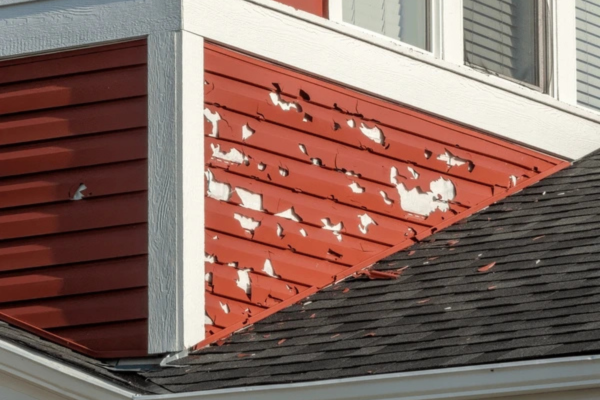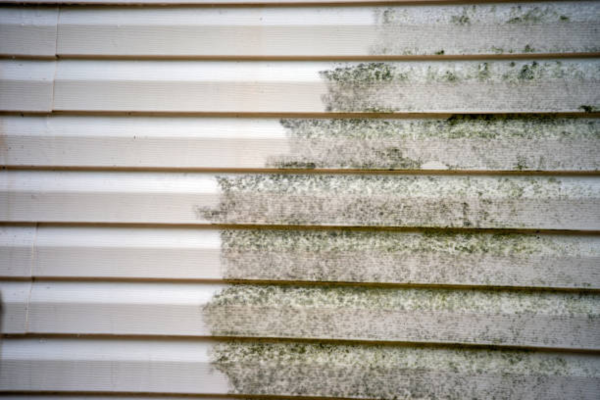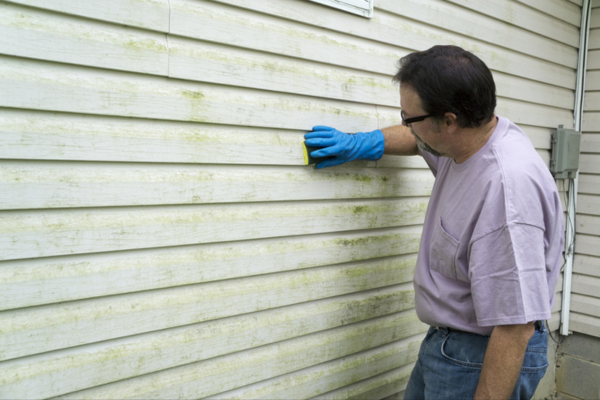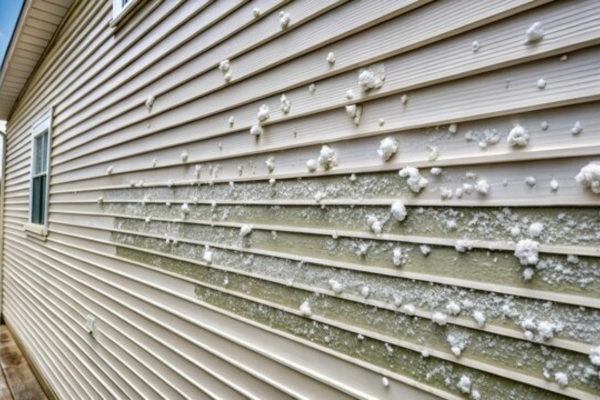Water damage on siding is more than just an eyesore—it’s a potential threat to your home’s structure and value. When water seeps through or accumulates behind your siding, it can cause mold growth, wood rot, and costly repairs. Recognizing the signs of water damage early and understanding its causes is crucial to keeping your home safe and sound.
As a homeowner, your goal should be to protect your investment by identifying potential issues before they escalate. This guide will help you understand what causes water damage on siding, how to spot the warning signs, and what steps to take to repair and prevent it. Whether you’re dealing with peeling paint or warped panels, taking action now can save you from extensive and expensive problems later.
1. What Causes Water Damage on Siding?
Understanding what leads to water damage on siding is the first step to preventing it. Below are the most common causes that every homeowner should know.
Poor Installation
Even the highest-quality siding can fail if it’s not installed correctly. Poor installation leaves gaps, misaligned panels, and insufficient sealing, all of which allow water to seep behind the siding. Over time, this hidden moisture can lead to wood rot, mold growth, and structural damage.
Weather-Related Damage
Extreme weather conditions such as heavy rain, snow, and storms can wreak havoc on your home’s exterior. Wind-driven rain can penetrate cracks or loose areas in the siding, while ice and snow can cause freeze-thaw cycles that crack and warp the material. Over time, even the most durable siding materials can succumb to the relentless forces of nature.
Faulty Gutters or Downspouts
Your gutter system plays a vital role in directing water away from your home. When gutters or downspouts are clogged or improperly installed, water can overflow and pool near your siding. Over time, this excess moisture can seep into the siding and cause long-term damage, including mold and rot.
Cracked Caulking or Seals
Caulking around windows, doors, and other siding joints serves as a protective barrier against moisture. When caulking becomes cracked, loose, or worn out, it leaves gaps where water can infiltrate. This is especially problematic around windowsills and door frames, which are already vulnerable areas.
Aging or Low-Quality Siding Materials
Siding materials don’t last forever, and low-quality options are particularly prone to water damage. As siding ages, it may develop cracks, warps, or other weaknesses that allow water to penetrate. Upgrading to high-quality, water-resistant siding can help protect your home for decades.
2. Signs of Water Damage on Siding

Recognizing the signs of water damage on siding early can save you from costly repairs and serious structural problems. Here are the most common indicators to watch for:
Peeling or Chipped Paint
If your siding is painted, peeling or chipping paint is often the first visible sign of water damage. Paint acts as a protective barrier, and when it starts to fail, moisture can seep into the underlying material. This is especially common in wood siding, where prolonged exposure to water can cause further deterioration.
Mold or Mildew Growth

Dark spots, greenish stains, or streaks on your siding can indicate mold or mildew growth. These fungi thrive in moist conditions, and their presence is a clear sign that water has infiltrated the area. Mold not only damages siding but can also pose health risks to you and your family.
Warped or Buckled Siding
Waterlogged siding materials can expand, warp, or buckle over time. This distortion is not just a cosmetic issue—it’s a sign that water has penetrated the siding and is causing internal damage. Warping can also make your siding less effective at keeping water out.
Soft or Rotting Wood
If you have wood siding, test for soft spots by gently pressing on the material. Soft or spongy areas indicate wood rot, a common result of prolonged water exposure. Left untreated, rot can compromise the structural integrity of your home.
Rusted or Loose Nails
Take a close look at the nails holding your siding in place. If they’re rusty, loose, or protruding, it’s a sign that moisture has seeped behind the siding, causing the materials to expand or shift. Rusted nails also weaken the siding’s stability.
Cracked or Damaged Window Trim
Siding damage often starts around windows and doors, where moisture can easily infiltrate. Cracked or deteriorating window trim is a red flag that water is finding its way behind the siding, potentially affecting the walls and insulation.
Discoloration or Streaking on the Siding
Visible streaks or discoloration, especially in vertical lines, are a telltale sign of water running down or pooling behind your siding. This is often caused by faulty gutters or downspouts, directing water onto the siding rather than away from it.
Increased Humidity or Water Spots Inside the Home
If you notice water stains, increased humidity, or musty smells inside your home, it could indicate water damage behind the siding. This secondary damage can affect drywall, insulation, and even your home’s structural framing.
3. What Happens if Water Gets Behind Siding?
When water gets behind siding, it doesn’t just stay hidden—it creates a cascade of problems that can affect your entire home. Here’s what you need to know about the potential risks:
Wood Rot and Structural Issues
Water trapped behind siding can cause wood rot, especially in the framing and sheathing of your home. Over time, rot weakens these critical structural components, leading to sagging walls, uneven floors, and costly repairs. For example, according to HomeAdvisor, repairing wood rot can cost anywhere from $1,000 to $7,000 depending on the extent of the damage.
Mold Growth and Health Hazards
Moist environments are a breeding ground for mold and mildew, which can spread quickly when water infiltrates your siding. Mold growth isn’t just unsightly—it poses serious health risks, including allergies, respiratory issues, and infections. If mold spreads into your walls, the cleanup process can become both extensive and expensive.
Decreased Home Value
Visible water damage on siding, along with mold or rot, can lower your home’s curb appeal and resale value. Potential buyers see water damage as a red flag, often associating it with ongoing maintenance problems. A home with damaged siding may sit on the market longer or fetch a lower price.
Escalating Repair Costs Over Time
The longer water damage goes unnoticed or untreated, the more expensive it becomes to fix. A small crack or leak might only cost a few hundred dollars to repair, but if left unaddressed, it could lead to thousands of dollars in structural repairs, mold remediation, and siding replacement.
Real-Life Example:
Imagine a homeowner who notices slight discoloration on their siding but decides to ignore it. Over a few years, that small issue turns into rotting wood, mold infestation, and significant interior damage. What could have been a $500 repair escalates into a $10,000 renovation project. This scenario highlights the urgency of addressing water damage on siding as soon as it’s detected.
4. How to Prevent Water Damage on Siding

Taking proactive steps to protect your siding from water damage is essential for maintaining the health and appearance of your home. Here are practical tips homeowners can follow to prevent water damage on siding:
Regularly Inspect Siding for Signs of Damage
Perform routine inspections of your siding at least twice a year and after heavy storms. Look for peeling paint, cracks, warping, or discoloration that could indicate water infiltration. Catching small issues early can prevent them from becoming major problems.
Ensure Gutters and Downspouts Are Functioning Correctly
Clogged or faulty gutters and downspouts are a leading cause of water pooling near siding. Regularly clean your gutters, ensure they’re securely attached, and check that downspouts direct water at least six feet away from your home’s foundation.
Reapply Caulking as Needed
Caulking around windows, doors, and siding joints deteriorates over time, creating gaps where water can enter. Check caulking annually and reapply as necessary to maintain a watertight seal.
Seal Cracks and Gaps Promptly
Small cracks or gaps in your siding can quickly lead to larger issues. Use weatherproof sealant or appropriate repair materials to patch these vulnerabilities before water has a chance to get in.
Choose High-Quality, Water-Resistant Siding Materials
Investing in durable, water-resistant siding materials like fiber cement or vinyl can offer long-term protection against water damage. These materials are designed to withstand harsh weather conditions and resist moisture better than traditional wood siding.
Trim Vegetation Away from Siding
Overgrown shrubs, vines, or trees can trap moisture against your siding, leading to mold growth and decay. Keep plants trimmed back at least a foot from your home’s exterior to allow for proper airflow and drainage.
5. Repairing Water-Damaged Siding
If your siding has already suffered water damage, prompt action is crucial to minimize further harm. Here’s a step-by-step guide to repairing water-damaged siding:
Step 1: Assess the Extent of the Damage
Begin by inspecting the affected area to determine how deep the damage goes. Is it just surface-level or has water seeped into the underlying materials? Look for soft spots, visible rot, and mold growth. This assessment will guide your next steps.
Step 2: Remove and Replace Damaged Sections
Carefully remove any siding that has been compromised. If you have wood siding, check the underlying sheathing and framing for rot or mold and replace those materials if necessary. For vinyl or fiber cement siding, replace only the damaged panels.
Step 3: Reapply Weatherproof Paint or Sealant
After replacing the damaged sections, apply a high-quality weatherproof paint or sealant to protect the new materials from future moisture exposure. This is especially important for wood siding, which needs a protective barrier to withstand the elements.
Step 4: Hire a Professional if the Damage Is Extensive
If water damage extends beyond the siding into your home’s structure, or if mold is present, it’s best to call in an expert. Professional contractors have the tools and experience to address complex repairs and ensure your home is fully protected.
6. The Cost of Ignoring Water Damage on Siding
Failing to address water damage on siding can lead to a cascade of problems that become increasingly expensive and harmful over time. Here’s a breakdown of the long-term implications:
Expensive Repairs If Left Unaddressed
Water damage doesn’t stay contained—it spreads. A small crack or peeling paint may seem insignificant, but over time, trapped moisture can lead to wood rot, structural damage, and even compromised insulation.
- Cost Comparison: Early repairs (e.g., sealing a crack or replacing a panel) might cost $100–$300. In contrast, major structural repairs due to prolonged neglect could run into the thousands of dollars.
Health Risks from Mold
One of the most dangerous consequences of water damage is mold growth. Mold thrives in damp, dark environments, which makes water-damaged siding an ideal breeding ground. Once mold infiltrates your home, it can cause respiratory issues, allergies, and other health complications.
- Mold remediation alone can cost between $1,500 and $3,500, depending on the severity.
Impact on Home Resale Value
Visible signs of water damage, like warped siding or mildew stains, can deter potential buyers and significantly reduce your home’s market value. Even if buyers are interested, they’ll likely negotiate for a lower price to account for the repairs they’ll need to make.
- Example: A home with pristine siding might sell for its full market value, while one with visible damage could lose 5%–10% of its value.
Motivating Action with Cost Comparisons
Imagine spending $200 on proactive maintenance today versus $10,000 on repairs five years down the line. The numbers speak for themselves—ignoring water damage on siding is a costly gamble that no homeowner can afford to take.
Water damage on siding can lead to costly repairs, health risks, and a decrease in your home’s value if left unaddressed. Acting quickly to identify and resolve the issue is the best way to protect your investment and your family’s safety. For professional water restoration services in New Jersey, contact Tri-State Ready Restoration today!
7. Frequently Asked Questions
What happens if water gets behind siding?
When water gets behind siding, it can lead to wood rot, mold growth, and damage to your home’s structure. Left unaddressed, this can result in costly repairs and potential health hazards from mold exposure.
What does water-damaged siding look like?
Water-damaged siding often shows signs like peeling paint, discoloration, warping, soft or spongy areas, and streaks or stains. Mold or mildew growth is another common indicator.
Can you repair damaged siding?
Yes, depending on the extent of the damage. Minor issues like small cracks or warping can often be repaired, but widespread damage, wood rot, or mold may require full replacement of the affected areas.
How much does it cost to replace damaged vinyl siding?
The cost to replace vinyl siding varies depending on the size of the area and material costs. On average, it ranges from $2 to $12 per square foot, with total project costs averaging between $1,000 and $4,000.
Will homeowners insurance cover siding replacement?
In some cases, homeowners insurance may cover siding replacement if the damage was caused by a covered peril, such as a storm or fire. However, gradual wear and tear or damage due to neglect are typically not covered. Check your policy for specific details.
How do you know if your siding needs to be replaced?
Signs that your siding needs replacement include visible warping, rot, extensive mold growth, significant discoloration, or repeated issues with water infiltration despite repairs.
What does mold look like on vinyl siding?
Mold on vinyl siding typically appears as black, green, or brown streaks or spots. It’s often found in shaded, damp areas where moisture accumulates, such as under eaves or near downspouts.

